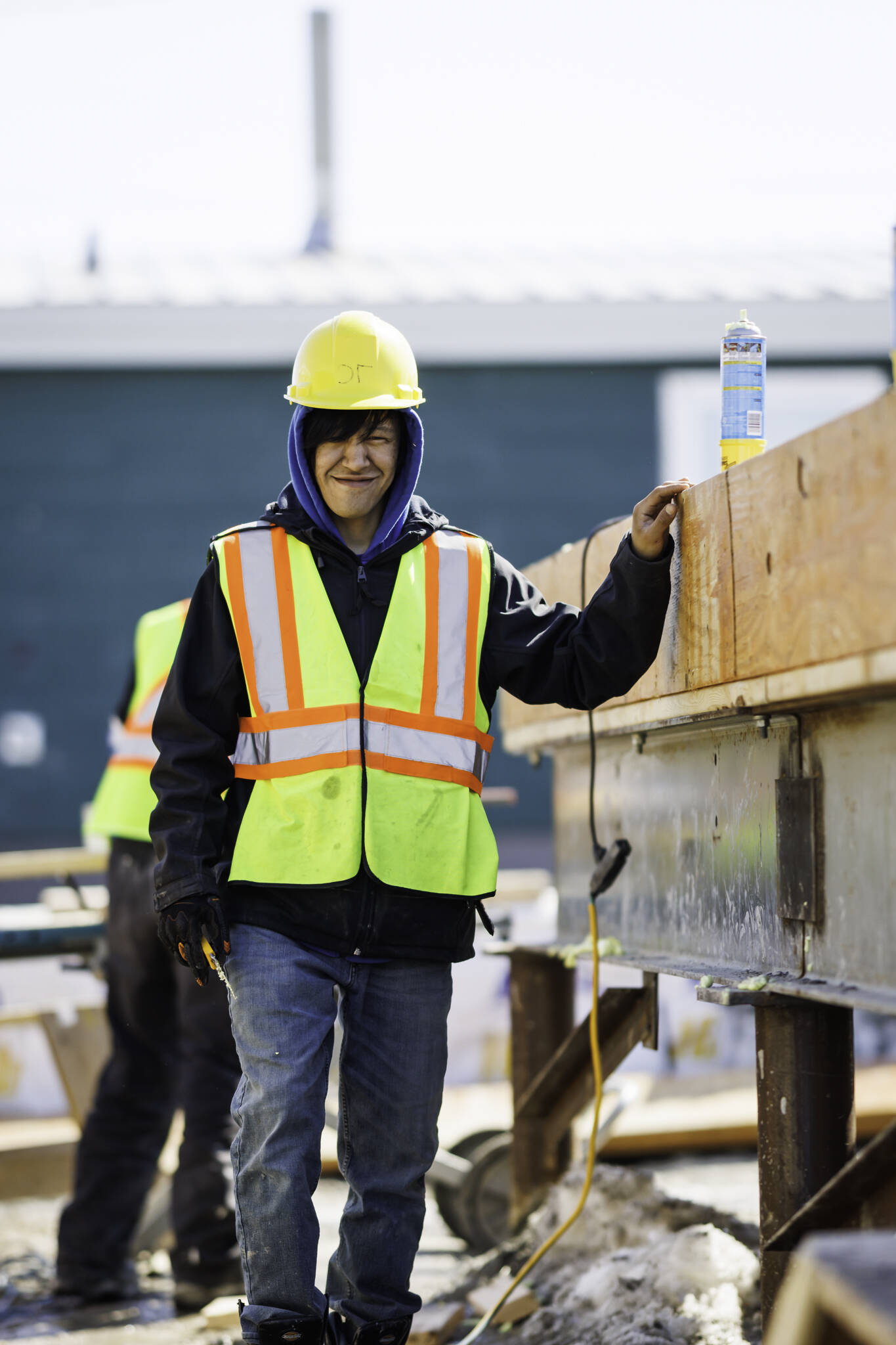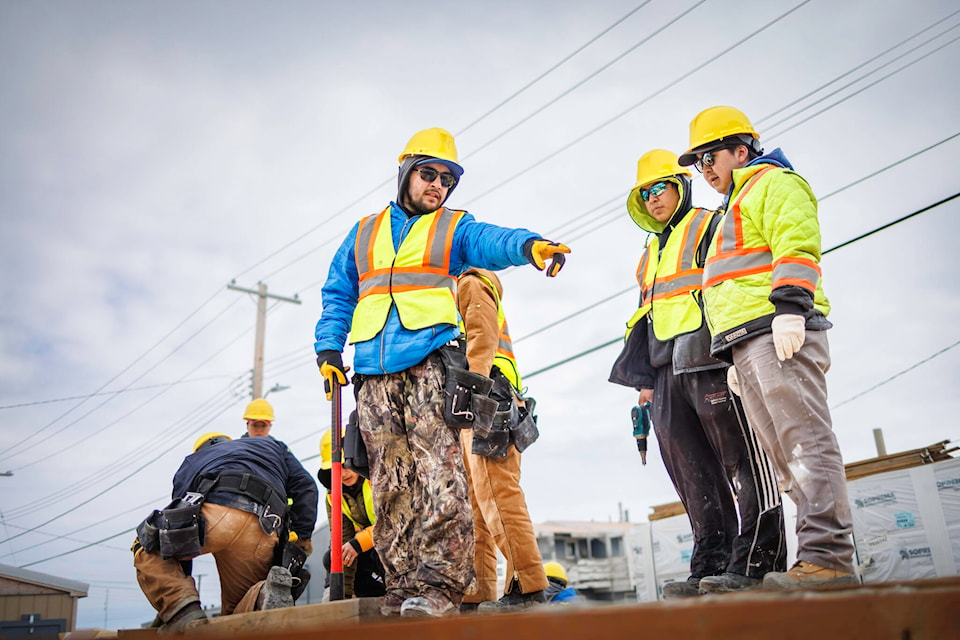ᓴᓇᑐᓕᓴᕐᕕᖕᒥ ᐃᓕᓐᓂᐊᖅᑐᑦ ᐃᓕᑦᑎᕙᓪᓕᐊᔪᑦ ᓄᓇᕐᔪᐊᕐᒥ ᖃᓄᐃᓕᐅᕈᑕᐅᕙᒃᑐᓂᒃ ᑲᖏᖅᖠᓂᕐᒥ ᐃᒡᓗᕐᔪᐊᓕᐅᖅᖢᑎᒃ ᐱᒋᐊᕈᑎᖓᓂ ᐃᓱᐊᓄᑦ ᓄᓇᕗᒥ ᐃᒡᓗᓕᕆᔨᕐᔪᐊᒃᑯᓐᓄᑦ ᐃᒡᓗᒋᔭᐅᓕᕐᓂᐊᖅᑐᒥᒃ.
“ᑕᒪᓐᓇ ᐱᓕᕆᐊᖑᔪᖅ ᐊᔾᔨᐅᙱᑦᑑᔪᖅ ᓄᓇᕗᒧᑦ,” ᑕᐃᒪᓐᓇ ᐅᖃᖅᖢᓂ ᐃᐅᐳᑦ ᓇᑦᓯᖅ, ᐃᒃᓯᕙᐅᑕᕆᔭᐅᔪᖅ ᐃᒡᓗᕐᔪᐊᓕᐅᕐᓂᕐᒧᑦ ᐃᓕᓐᓂᐊᕈᑎᓂᒃ ᓄᓇᕗᒥ ᓯᓚᑦᑐᖅᓴᕐᕕᒡᔪᐊᕐᒥ ᑲᖏᖅᖠᓂᕐᒥ.
ᑕᒪᓐᓇ ᐱᒻᒪᕆᐅᑎᑕᖓ ᓴᓇᔭᒃᓴᖅᑖᕈᑕᐅᔪᓐᓇᕐᓂᐊᕐᒪᑦ ᐃᓕᓐᓂᐊᖅᑐᓄᑦ, ᐱᑕᖃᕆᐊᖃᓪᓚᕆᒃᑎᓪᓗᒍ ᓴᓇᔭᒃᓴᓂᒃ: ᑕᐃᑉᓱᒪᓂ, ᐊᑕᐅᓯᖅ ᖁᓕᐅᔪᓂᒃ ᐃᓕᓐᓂᐊᖅᑐᓂᒃ ᓄᓇᕗᒥ ᓯᓚᑦᑐᖅᓴᕐᕕᒃᑰᖅᓯᒪᔪᓂᒃ ᐊᓕᓚᔪᖅᑖᕈᑎᒃᓴᒧᑦ ᐃᓕᓐᓂᐊᖅᑳᖅᖢᑎᒃ ᓴᓇᔭᒃᓴᖅᑖᖃᑦᑕᓚᐅᖅᑐᑦ, ᑕᐃᒪᓐᓇ ᐅᖃᖅᖢᓂ.
“ᑕᒪᓐᓇ ᐊᒥᒐᖅᑐᓂᒃ ᓴᖅᑭᑎᑦᑎᓯᒪᔪᖅ,” ᑕᐃᒪᓐᓇ ᐅᖃᖅᖢᓂ ᓇᑦᓯᖅ. “ᐃᓕᓐᓂᐊᕐᕕᖕᒥ ᐃᓕᓐᓂᐊᖅᑎᑦᑎᙱᑐᐃᓐᓇᖅᑐᑦ ᐅᒃᐱᕆᔭᐅᔪᓂᒃ; ᐃᓕᓐᓂᐊᖅᑎᑦᑎᔪᑦᑕᐅᖅ ᖃᐅᔨᒪᔭᐅᒐᔪᒃᑐᓂᒃ, ᐃᓕᓐᓂᐊᖅᑎᑕᐅᑉᓗᑎᒡᓗ ᓴᓇᔭᒃᓴᖅᑖᕈᑎᒃᓴᓂᒃ ᐃᓕᑕᕆᔭᐅᔾᔪᑎᑖᕈᑎᒋᓂᐊᖅᑕᖏᓐᓂᒃ ᓯᕗᒻᒧᐊᒃᐸᓪᓕᐊᔾᔪᑎᒃᑯᑦ.”
ᐃᒻᒪᖄ 16 ᐃᓕᓐᓂᐊᖅᑐᑦ ᓄᓇᕗᒥᐅᑕᑦ ᑕᒪᑐᒥᙵ ᐱᓕᕆᐊᓖᑦ, ᐱᓕᕆᐊᖑᒋᐊᓚᐅᖅᑐᖅ ᒫᓐᓇᓵᖑᓯᒪᔪᖅ ᓂᕆᐅᓇᙱᑦᑐᑦ ᓴᖅᑭᖃᑦᑕᓚᐅᕐᓂᖏᓐᓄᑦ ᖃᑯᒍ ᐱᓕᕆᐊᖑᓇᔭᕐᓂᖓᓄᑦ ᐊᒻᒪᓗ ᓄᕙᒡᔪᐊᕐᓂᒃᑯᑦ ᑭᖑᕙᕆᐊᕈᑕᐅᓚᐅᖅᑐᑦ ᑕᐃᒪᐅᓚᐅᖅᑎᓪᓗᒋᑦ. ᒫᓐᓇᐅᔪᖅ ᑕᒪᓐᓇ ᐱᓕᕆᐊᖑᒋᐊᕆᐊᖃᓚᐅᖅᑑᒐᓗᐊᖅ ᐅᑭᐊᒃᓵᖑᓚᐅᖅᑐᖅ ᐊᕐᕌᓂ, ᐃᓕᓐᓂᐊᖅᑐᑦ ᐊᔪᕈᓐᓃᖅᓴᖃᑦᑕᓚᐅᖅᑐᑦ ᐱᓕᕆᐊᒥᓂᒃ ᓴᓇᑉᓗᑎᒃ ᓯᕐᓗᐊᕐᓂᒃ ᐃᒡᓗᕋᓛᕐᓂᒡᓗ, ᐊᒻᒪᓗ ᒫᓐᓇᓵᖑᓯᒪᔪᕐᓗ ᓄᑖᙳᖅᑎᕆᓚᐅᖅᖢᑎᒃ ᐃᒡᓗᒥᒃ Area 5−ᒥ ᑲᖏᖅᖠᓂᕐᒥ.
“ᐅᒃᐱᕈᓱᒃᑐᖓ ᑕᑯᑎᑦᑎᔭᕆᐊᖃᓚᐅᕋᑉᑕ ᐊᔪᙱᓐᓂᕆᔭᑉᑎᓐᓂᒃ ᓯᕗᓪᓕᖅᐹᒃᑯᑦ,” ᑕᐃᒪᓐᓇ ᐅᖃᖅᖢᓂ ᓇᑦᓯᖅ. “ᓄᑖᙳᖅᑎᕆᐊᓂᒃᑲᑉᑕ ᓄᑖᙳᖅᑎᑦᑕᐅᔭᕆᐊᓕᖕᒥᒃ, ᐅᔾᔨᕆᔭᐅᓕᓚᐅᖅᑐᒍᑦ ᑕᐃᒪᐃᑦᑐᓕᕆᔪᓐᓇᕐᓂᑉᑎᓐᓄᑦ.”
ᑕᒪᓐᓇ ᑕᒡᕙ ᐱᒋᐊᕈᑕᐅᓚᐅᖅᑐᖅ ᐊᖏᔪᒥᒃ ᐱᓕᕆᐊᖃᕈᓐᓇᖅᓯᓂᕐᒧᑦ: ᓴᓇᓂᕐᒧᑦ ᐃᒡᓗᒥᒃ ᐱᒋᐊᕈᑎᒃᑯᑦ, ᑕᒪᓐᓇ ᑲᔪᓯᓂᖃᑦᑎᐊᓕᖅᑐᖅ. ᐅᖓᓯᒃᓯᒋᐊᕈᑕᐅᓚᐅᖅᑐᑦ ᐱᒻᒪᕆᐅᓚᐅᕐᒥᔪᑦ, ᑕᐃᒪᓐᓇ ᐅᖃᖅᖢᓂ ᓇᑦᓯᖅ.
“ᑕᒪᓐᓇ ᐃᓕᓐᓂᐊᖅᑎᑦᑎᓯᒪᔪᖅ ᐃᓕᓐᓂᐊᖅᑐᖁᑎᑉᑎᓐᓄ, ᓱᓇᓗᒃᑖᑦ ᓴᖅᑭᑦᑕᕆᐊᓖᑦ ᓴᖅᑮᓐᓇᖃᑦᑕᔾᔮᙱᒻᒪᑕ ᑭᖑᕙᕆᐊᕈᑎᑕᖃᖃᑦᑕᕐᓂᐊᕐᒪᑦ,” ᑕᐃᒪᓐᓇ ᐅᖃᖅᖢᓂ. “ᑐᕌᕐᕕᒋᔭᕆᐊᖃᖅᑕᖅᐳᑦ, ᐊᐅᓚᑦᑐᓐᓇᖃᑦᑕᙱᓐᓇᑉᑎᒍᑦ, ᐸᕐᓇᑐᐃᓐᓇᖃᑦᑕᖅᑕ ᑲᒪᒋᔭᐅᔭᕆᐊᓕᖕᓂᒃ ᒫᓐᓇᐅᔪᖅ.”
ᐃᒡᓗᕋᓛᖅ − ᐊᒧᔭᒃᓴᓕᐊᖑᓚᐅᖅᑐᖅ ᓵᓚᒃᓴᖅᑕᐅᑉᓗᓂᓗ − ᓯᕐᓗᐊᕐᓗ ᓴᓇᔭᐅᓂᖓ ᐃᓕᓐᓂᐊᕈᑕᐅᓚᐅᖅᑐᖅ ᐃᓕᓐᓂᐊᖅᑐᓄᑦ ᐃᒡᓗᓕᐅᕐᓂᒃᑯᑦ ᒪᓕᒐᒃᓴᕆᔭᐅᕙᒃᑐᓂᒃ, ᐅᖃᐅᓯᓕᕆᓂᒃᑯᓪᓗ ᐊᒻᒪᓗ ᓱᓇᑦ ᐊᑐᖅᑕᐅᕙᒃᑐᑦ ᐱᐅᓂᖅᐹᖑᖕᒪᖔᑕ.
ᒫᓐᓇᐅᔪᖅ ᐊᑐᖅᑕᐅᕙᓪᓕᐊᓕᖅᑐᑦ ᓴᓇᔪᓪᓗ ᐃᒡᓗᒃᓴᒥᒃ ᓄᓇᕗᒥ ᐃᒡᓗᓕᕆᔨᕐᔪᐊᒃᑯᓐᓄᑦ ᐱᒋᔭᐅᓕᕐᓂᐊᖅᑐᒥᒃ ᐱᐊᓂᒃᑕᐅᒃᐸᑦ.
“ᐃᒡᓗᓕᕆᔨᕐᔪᐊᒃᑯᑦ ᐃᑲᔪᖅᓯᒪᓪᓚᕆᒃᑐᑦ ᐊᒻᒪᓗ ᑐᑭᓯᐅᒪᑉᓗᑎᒃ ᑕᒪᓐᓇ ᐃᓕᓐᓂᐊᕈᑕᐅᖕᒪᑦ ᐱᕕᒃᓴᖃᖅᑎᑦᑎᓂᖅᓴᐅᑉᓗᑎᒃ ᑳᓐᑐᕌᒃᑎᐅᔪᓂᐅᖓᓂ,” ᑕᐃᒪᓐᓇ ᐅᖃᖅᖢᓂ.
ᐃᓕᓐᓂᐊᖅᑐᑦ ᐱᕕᒃᓴᖃᖅᑎᑕᐅᔪᑦ ᒪᕐᕉᖕᓂᒃ ᐅᑭᐅᓂᒃ ᐱᐊᓂᒃᓯᓂᐊᕐᓂᕐᒧᑦ ᐃᒡᓗᒥ, ᑭᓯᐊᓂ ᓇᑦᓯᖅ ᐅᒃᐱᕈᓱᒃᑐᖅ ᐱᐊᓂᒃᑕᐅᓂᐊᕐᓂᖓᓄᑦ ᕿᓚᒻᒥᐅᓂᖅᓴᒃᑯᑦ.
ᖁᓕᕇᓕᐅᔾᔮᙱᑦᑐᖅ ᐃᒡᓗ, ᐃᒻᒪᖄ 1,300 ᑭᑉᐹᕆᒃᑐᒃᑯᑦ feet-ᑯᑦ ᐊᖏᓂᖃᕐᓗᓂ ᐊᒻᒪᓗ ᓴᓇᔭᐅᓯᒪᓂᖓ ᑐᕌᖓᓂᖅᓴᐅᓂᐊᖅᖢᓂ ᐅᑭᐅᖅᑕᖅᑐᒥ ᓴᓇᔭᐅᓯᒪᔭᕆᐊᖃᖅᑐᑎᑐᑦ, ᓲᕐᓗ ᖁᑭᐅᑕᐅᓯᕝᕕᒃᑕᖃᕐᓗᓂ.
ᓇᑦᓯᖅ ᑕᒪᑐᒥᙵ ᐃᓱᒪᓕᐅᖅᖢᓂ ᐃᓱᒪᒋᔭᖃᓕᓚᐅᖅᑐᖅ ᐳᓚᕋᖅᖢᓂ ᐃᐅᓪᒐᓐᑯᐃᓐ ᓯᓚᑦᑐᖅᓴᕐᕕᖕᒥ ᐊᑐᕚᒥ.
“ᐃᓕᑦᑎᕚᓪᓕᕐᓇᓚᐅᖅᑐᖅ ᖃᓄᖅ ᓯᓚᑦᑐᖅᓴᕐᕕᒃ ᐃᑲᔪᖅᓯᒪᓂᖓᓄᑦ ᓄᓇᓕᖕᒥ, ᐊᒻᒪᓗ ᓄᓇᓕᐅᔪᖅ ᐃᑲᔪᖅᓯᒪᓂᖓᓄᑦ ᓯᓚᑦᑐᖅᓴᕐᕕᖕᒥ,” ᑕᐃᒪᓐᓇ ᐅᖃᖅᖢᓂ. “ᐃᓱᒪᓕᓚᐅᖅᑐᖓ ᑕᐃᒪᓐᓇᑦᑕᐅᖅ ᐱᓕᕆᔪᓐᓇᕐᓂᑉᑎᓐᓄᑦ ᑕᒫᓂ, ᐃᒡᓗᓕᐅᕈᓐᓇᖅᑐᒍᑦ ᐅᑭᐅᖅᑕᖅᑐᒥ ᓴᓇᑐᓕᓴᕐᕕᒃᑯᑎᒍᑦ.
ᐃᓱᒪᒋᔭᖓᒍᑦ, ᓇᑦᓯᖅ ᐊᑐᕈᒪᔪᖅ ᐊᑐᕈᓐᓇᖅᑕᒥᓂᒃ ᓄᓇᓕᖕᒥ ᐃᒡᓗᓕᐅᕐᓂᒃᑯᑦ ᐊᑭᑐᔫᑎᒃᑯᑦ ᑮᓇᐅᔭᖁᑎᖏᑦᑎᒍᑦ ᐃᓕᓐᓂᐊᖅᑎᑦᑎᓗᑎᒃ ᐃᓕᓐᓂᐊᖅᑐᓂᒃ ᐃᖕᒥᓄᑦ ᐊᑑᑎᖃᓕᕐᓂᐊᖅᑐᒃᑯᑦ.
“ᑕᒪᓐᓇ ᐱᒻᒪᕆᐊᓗᒃ ᑕᐅᑐᒃᑕᒃᑯᓪᓕ ᐱᕕᒃᓴᕆᔪᓐᓇᖅᑕᖅᐳᑦ ᓴᖅᑭᒐᔪᙱᒻᒪᑕ,” ᑕᐃᒪᓐᓇ ᐅᖃᖅᖢᓂ ᓇᑦᓯᖅ.
ᐃᒡᓗᓕᐅᖅᑎᙳᕋᓱᒃᖢᓂ ᐊᒃᓱᕈᕐᓇᖅᑑᔪᓐᓇᖅᑐᖅ, ᐱᓗᐊᖅᑐᒥ ᓅᑦᑕᕆᐊᖃᖃᑦᑕᖅᖢᓂ ᓄᓇᓕᖕᒥ ᓄᓇᓕᖕᒧᑦ ᐃᓂᒃᓴᖅᓯᐅᕋᓱᒃᖢᓂᓗ ᑐᔪᕐᒥᕕᖕᒥᒃ ᐃᒡᓗᒃᓴᒥᒃ, ᑕᐃᒪᓐᓇ ᑐᑭᓯᑎᑦᑎᒋᐊᖅᖢᓂ. ᑕᒪᓐᓇ ᐱᓕᕆᐊᖑᔪᖅ ᐃᓕᓐᓂᐊᖅᑐᓄᑦ ᐃᓕᑦᑎᔾᔪᑕᐅᓂᐊᖅᑐᖅ ᐃᓕᑦᑐᓐᓇᕋᔭᖅᑕᖏᓐᓂᒃ ᓴᓇᓪᓚᑦᑖᖅᖢᓂ ᑭᓯᐊᓂ.
“ᑕᒪᓐᓇ ᐊᔪᕐᓇᙱᓐᓂᖅᓴᐅᔾᔪᑕᐅᓂᐊᖅᑐᖅ ᐃᒡᓗᓕᐅᖅᑎᐅᔪᒪᓂᐊᖅᖢᓂ ᐃᓕᓐᓂᐊᕈᒪᓂᐊᖅᖢᓂ, ᐊᔪᙱᓐᓂᕐᒥᓂᒃ ᐱᕙᓪᓕᐊᑎᑦᑎᓗᑎᒃ ᖃᐅᔨᒪᔭᒥᓂᒡᓗ, ᐊᒻᒪᓗ ᐱᕕᒃᓴᖃᕐᓂᖅᓴᐅᓕᕋᔭᖅᑐᑦ ᑭᓇᑐᐃᓐᓇᕐᒥᒃ ᓄᓇᖅᑲᑎᒥᓂᒃ,” ᑕᐃᒪᓐᓇ ᐅᖃᖅᖢᓂ ᓇᑦᓯᖅ, ᐱᓕᕆᓪᓚᑦᑖᖅᖢᓂ ᑕᒪᓐᓇ ᐃᓕᑦᑎᕙᓪᓕᐊᓐᓇᕐᒪᑦ ᐃᓕᓐᓂᐊᕋᓱᒃᖢᓂ ᐊᒥᒐᓚᐅᖅᑐᒃᑯᑦ.
“ᖃᐅᔨᒪᔭᐅᔭᕆᐊᓕᖕᓂᒃ ᖃᐅᔨᒪᑉᓗᓂ ᐱᓕᕆᐊᖃᖅᓯᒪᓂᑰᑉᓗᓂᓗ, ᐅᒃᐱᕈᓱᖕᓂᖅ ᑕᐃᒪᑑᔭᕆᐊᖃᙱᒻᒪᑦ. ᐱᓕᕆᐊᖃᖅᓯᒪᓂᑰᔭᕆᐊᖃᕐᓇᕐᒪᑦ.”
ᑐᒥ ᐊᓇᕈᐊᖅ ᒪᒃᑯᒃᑑᖃᑕᐅᔪᖅ ᐱᓕᕆᔪᓂᒃ.
“ᐊᓕᐊᓇᐃᒋᑦᑎᐊᖅᑕᕋ,” ᑕᐃᒪᓐᓇ ᐅᖃᖅᖢᓂ. “ᐊᓕᐊᓇᐃᑦᑐᒻᒪᕆᐊᓗᒃ. ᐃᓚᐅᖃᑕᐅᔪᒪᐃᓐᓇᖃᑦᑕᖅᓯᒪᔪᖓ ᐃᒡᓗᓕᐅᖅᑐᓂᒃ. ᐃᒡᓗᓕᐅᖅᑐᓂᒃ ᑕᐅᑐᖃᑦᑕᖅᓯᒪᔪᖓ ᐱᕈᖅᓴᖅᖢᖓ. ᐃᓕᑦᑎᕙᓪᓕᐊᑦᑎᐊᖅᑐᖓ. ᐊᒥᓱᓂᒃ ᖃᐅᔨᒪᓚᐅᙱᑦᑐᖓ ᐱᓕᕆᐊᖑᕙᒃᑐᓂᒃ.”
ᖃᓄᖅ ᓇᑎᖅ ᓇᓕᒧᒌᑦᑎᐊᕋᔭᕐᒪᖔᑦ ᐃᓕᓐᓂᐊᖅᑕᖓ ᑕᒡᕘᓇ ᐃᒡᓗᓕᐅᕐᓂᒃᑯᑦ, ᐊᒻᒪᓗ ᖃᓄᖅ ᑕᐃᒎᓯᖃᕐᒪᖔᑕ ᓴᓇᕐᕈᑏᑦ.
“ᐊᒥᓲᖕᒪᑕ ᑕᐃᒎᓯᕆᔭᐅᔪᑦ ᓴᓇᕐᕈᑎᓄᑦ, ᑭᓯᐊᓂ ᐃᓕᑉᐸᓪᓕᐊᔭᒃᑲᑦᑕᐅᖅ,” ᑕᐃᒪᓐᓇ ᐅᖃᖅᖢᓂ. “ᐃᓚᖓᒍᑦ , ᐃᖢᐊᖏᓕᐅᕈᑎᖃᓗᐊᓚᐅᙱᑦᑐᖅ ᐃᓕᓐᓂᐊᕐᓂᖅ. ᐃᑲᔪᖅᑑᑎᑦᑎᐊᕋᑉᑕ. ᐊᓕᐊᓇᐃᑦᑐᖅ.”
ᐅᖁᖅᓴᐅᑎᓕᕆᔨᙳᕈᒪᓯᒪᔪᖅ.
ᓇᑦᓯᖅ ᐅᖃᖅᖢᓂ ᐃᓕᓐᓂᐊᖅᑐᑦ ᐱᑖᑐᐃᓐᓇᔾᔮᙱᑦᑐᑦ ᑕᑯᑎᑦᑎᔪᓐᓇᖅᓯᓂᕐᒧᑦ ᐊᔪᙱᓐᓂᕐᒥᓂᒃ ᐃᓕᓐᓂᐊᖅᓯᒪᓂᕐᒥᓂᒡᓗ, ᑭᓯᐊᓂ ᓴᓇᔭᒃᓴᖅᑖᕋᓱᒃᖢᓂ ᑕᑯᑎᑦᑎᔪᓐᓇᖃᑦᑕᕐᓂᐊᖅᑐᑦ ᐃᓄᖕᓂᒃ ᖃᐅᔨᓯᒪᔪᓂᒃ ᐊᔪᙱᓐᓂᖏᓐᓂᒃ ᓯᕗᓂᒃᓴᒧᑦ ᓴᓇᔭᒃᓴᖅᑖᕈᑎᒃᓴᒃᑯᑦ.
“ᑕᐃᑲᓂᑦᑕᐃᓐᓇᖅ, ᐅᖃᐅᑎᖃᑦᑕᖅᑕᒃᑲ ᐃᓕᓐᓂᐊᖅᑐᑦ, ᑕᒪᓐᓇ ᐱᔪᒪᔭᕆᐊᖃᖅᑕᓯ,” ᑕᐃᒪᓐᓇ ᐅᖃᖅᖢᓂ ᓇᑦᓯᖅ. “ᑕᐃᑲᓂ ᑲᑎᖃᑎᒋᔪᓐᓇᖃᑦᑕᖅᑕᑉᓯ. ᑭᓯᐊᓂ ᑕᒪᓐᓇ ᐱᔪᒪᙱᒃᑯᑉᓯᐅᒃ ᐊᒻᒪᓗ ᓇᖕᒥᓂᕆᓇᓱᙱᒃᑯᑉᓯᐅᒃ, ᖃᓄᒃᑲᓐᓂᖅ ᐃᑲᔪᕈᓐᓇᙱᑕᑉᓯ. 100%-ᒥᒃ ᐃᑲᔪᕈᓐᓇᕐᓂᓗᒃᑖᒻᓂᒃ ᐃᑲᔪᕐᓂᐊᖅᑕᑉᓯ. ᐃᖕᒥᓂᒃᑕᐅᖅ 100%-ᒥᒃ ᑐᓂᓯᓯᒪᔭᕆᐊᓖᑦ. ᕿᑎᐊᓂ ᑲᑎᒃᑯᑉᑕ, ᓄᖅᑲᖓᑎᑕᐅᓯᒪᔮᙱᑦᑐᒍᑦ ᐱᕕᒃᓴᖃᕈᓐᓇᕐᓂᕐᒧᑦ ᓄᓇᕗᒥ.”
ᖁᔭᓐᓇᒦᖅᖢᓂ ᑕᒪᐃᓐᓂᒃ ᐃᑲᔪᖅᓯᒪᔪᓂᒃ ᑕᒪᓐᓇ ᐱᓕᕆᐊᖑᔪᖅ ᓴᖅᑭᑦᑐᓐᓇᖁᑉᓗᒍ ᑐᓂᔭᐅᓯᒪᖕᒪᑕ ᐊᒻᒪᓗ ᑮᓇᐅᔭᖅᑖᖅᑎᑕᐅᓯᒪᑉᓗᑎᒃ, ᐃᓚᐅᖃᑕᐅᑉᓗᒋᑦ ᓴᒃᑯᒃᑯᑦ, ᐃᓚᒌᖕᓂᒃ ᐱᔨᑦᓯᕋᖅᑎᒃᑯᑦ ᒐᕙᒪᒃᑯᓐᓂᒃ ᐊᒻᒪᓗ ᓄᓇᕗᒥ ᐃᒡᓗᓕᕆᔨᕐᔪᐊᒃᑯᑦ.
“ᐱᓕᕆᖃᑎᒋᕙᒃᑕᖅᐳᑦ ᑕᐃᒪᐅᓚᐅᙱᑉᐸᑕ, ᑕᐃᒪᐃᓕᐅᕈᓐᓇᕋᔭᓚᐅᙱᑦᑐᒍᑦ,” ᑕᐃᒪᓐᓇ ᐅᖃᖅᖢᓂ.
Trades students are getting some real-world experience in Rankin Inlet by building an entire house from the ground up that will eventually be a Nunavut Housing Corporation property.
“This project is a very unique project for Nunavut,” said Albert Netser, chair of construction trades at Nunavut Arctic College in Rankin Inlet.
He’s passionate about the project because of the career potential it will give students, something that is sorely needed.
In the past, about one out of 10 students who went through the NAC program got into an apprenticeship and found employment, he said.
“This is filling that gap,” said Netser. “The school is not only teaching theory; it’s teaching practical knowledge, as well as giving gainful work experience that will be accredited toward their apprenticeship moving on ahead.”
About 16 students from around the territory are working on the project, which only began recently due to some unforeseen scheduling and pandemic delays. In the meantime since the project was supposed to begin last fall, the students practised their skills by building shacks and cabins, and they more recently renovated a building in Area 5 in town.
“I believe we had to show our capability there first,” said Netser. “When we finished that renovation, it put our foot in the door and our name out there that we can do this.”
That was all a leadup to the big project: building a single-family dwelling from scratch, now fully underway. And even the delays had value, said Netser.
“That teaches our students, and us as well, things might not work out as per schedule,” he said. “Where we have to go, it’s out of our hands, let’s plan for the next step now.”
The cabin – one of which was recently raffled off to a lucky winner - and shack work helped teach students some construction standards, terminology and best practices.
Now, they’re putting it all into practice and building a home that the Nunavut Housing Corporation will take over when complete.
“Housing Corp has been very generous with helping us out and understanding that this is a training ground and giving us more time than they would to a regular contractor,” he said.
The students have two years to finish the house, but Netser is confident it will be done sooner.
It will be a one−floor ‘bungalow’ house, roughly 1,300 square feet and include furnishings that make it relevant to the north, like a gun cabinet.
Netser got the idea for the project during a visit to Algonquin College in Ottawa.
“It was an eye opener how the college was helping the community, and the community helping the college,” he said. “I thought, if they can do that here, we can build houses up north with the trade school.”
Ideally, Netser hopes to take advantage of opportunities in communities pursuing construction projects in their capital budgets by specifically training up students to be able to work for them.
“This is very important in my eyes because opportunities are very few and far between,” said Netser.
Getting into construction can be hard, especially if it requires moving from community to community and trying to find accommodations, he explained. This project gives students the experience they would only previously be able to get through real employment.
“It makes it easier for people to get into construction trade, build their skills and their knowledge, and then they would have a leg up on just anybody off the street,” said Netser, calling the hands-on experience the missing part of the program before.
“Without the practical knowledge and experience, just having theory is not good enough,” he continued. “You need the experience.”
Tumi Anawak is one of the young builders on the site.
“I’m loving it,” he said. “It’s a lot of fun. I’ve always wanted to be a part of house builds. I’ve always seen it growing up. I’m learning a lot. There are lots of things I didn’t know.”
How to make the flooring straight is something he’s learned on the house project, as well as different tools’ names.
“There’s so many names for all the tools, but I’m getting the hang of that too,” he said. “For the most part, there wasn’t too much problems with learning. Everyone’s helping each other. It’s pretty awesome.”
He’s hoping to eventually become an oil burner mechanic.
Netser said the students will not only receive a big piece on their resumes, but references from the college for future employers.
“All at the same time, I’m telling my students, you have to want it as well,” said Netser. “We can meet you there. But if you don’t want it and you don’t have the attitude for it, then there’s nothing I can do to help you. I’ll give 100 per cent for my half. And they have to give 100 per cent for their half. When we meet in the middle, then there’s nothing stopping us in creating more opportunities for Nunavut.”
He thanked all the partners for helping make the project possible with donations and funding, including Sakku Investments, Family Services and Nunavut Housing Corporation.
“If it weren’t for my partners, this wouldn’t have been possible,” he said.
![]()



